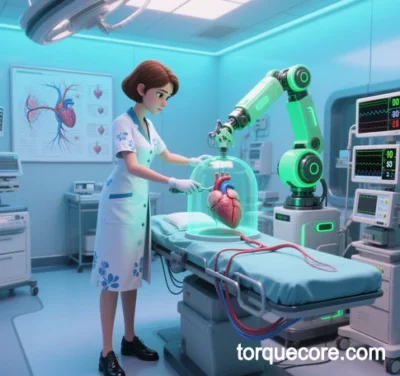
Synergistic Analysis of Torque Transmission and Core Structure (TorqueCore) in Cardiovascular Surgery
An In-Depth Exploration of Guidewire Design and Clinical Practice
I. Torque Transmission: A Core Technical Requirement in Cardiovascular Interventions
In complex vascular pathways (e.g., chronic total occlusions, calcified tortuous vessels), a guidewire’s torque transmission capability directly determines procedural success. Ideal torque transmission requires:
- 1:1 Torque Response: Rotational force applied proximally must transmit undiminished to the distal tip. For example, the CrossBoss™ catheter uses a multi-coil shaft design to synchronize proximal and distal torque.
- Deformation Resistance: Maintain structural rigidity in stenotic or calcified lesions. The Tenor® guidewire employs stainless steel core technology to minimize bending under pressure.
- Dynamic Adaptability: Adjust torque output in real time to accommodate vascular anatomy. The Turnpike® catheter’s bidirectional coil design enables clockwise/counterclockwise torque transmission for navigating tortuous paths.
Clinical Impact:
- Reduced Procedure Time: The ROTAWIRE™ Drive guidewire optimizes torque transmission, cutting time for crossing calcified lesions by 30%.
- Lower Complication Risk: 1:1 torque control prevents vascular perforation caused by lag, as seen in Stingray™ guidewire’s precision during true lumen re-entry.
II. Engineering Innovations in Core Structure (TorqueCore)
The core structure balances mechanical performance and biocompatibility:
1. Material & Layered Design
- Composite Core: Hybrid designs (e.g., Shenzhen HT Medical’s guidewire) combine a flexible nitinol tip with a rigid stainless steel proximal section for precise control and support.
- Torque Layer Optimization: St. Jude Medical’s catheter uses braided mesh (5–100 PPI density) with PTFE lining to balance flexibility and pushability.
2. Tip Engineering
- Tapered Core Design: The Asahi Miracle Bros guidewire tapers from 0.4 mm (proximal) to 0.1 mm (distal), ensuring penetration power without vessel damage.
- Smart Coatings: Abbott Whisper’s polyurethane coating reduces friction (coefficient below 0.05), boosting torque efficiency by 40%.
3. Dynamic Response Mechanisms
- AI-Driven Stress Modeling: High-end guidewires (e.g., Teleflex Turnpike®) use FPGA-processed biomechanical models to predict tissue interactions and adjust torque dynamically.
III. Clinical Applications in Complex Vascular Pathways
| Lesion Type | Challenge | Solution | Outcome |
|---|---|---|---|
| Calcified Tortuous Vessels | Guidewire jamming/breakage | ROTAWIRE™ Drive: Enhanced core hardness (>80 GPa) + hydrophilic coating | 25% faster procedures; 0.5% perforation rate |
| Chronic Total Occlusion | Fibrous cap penetration failure | CrossBoss™: Hollow metal shaft + blunt tip for 1:1 torque transmission | 92% true lumen re-entry success |
| Bifurcation Lesions | Poor branch accessibility | Stingray™: 28° pre-shaped tip + 180° dual-balloon design (±2° torque accuracy) | 98% dual-stent kissing success |
IV. Challenges & Future Directions
Current Limitations:
- Multiphysics Complexity: Torque transmission involves fluid dynamics (blood flow), solid mechanics (vessel deformation), and thermodynamics (friction), challenging existing models.
- Material Fatigue: Repeated torsion causes microcracks in nitinol cores, necessitating self-healing coatings or carbon fiber composites.
Emerging Frontiers:
- Quantum-Classical Hybrid Computing: IBM QFold simulates atomic-level stress distribution to optimize torque pathways (10,000x faster).
- Self-Evolving Control: FPGA-based reinforcement learning (e.g., Xilinx Versal AI Core) enables real-time adaptation to operator techniques.
- Biodegradable Cores: Magnesium or PLA materials degrade post-procedure, reducing foreign body risks.
Conclusion
The synergy between torque transmission and TorqueCore innovation marks a paradigm shift from passive tools to intelligent systems in cardiovascular interventions. Modern guidewires achieve submillimeter mechanical control through material science, biomechanics, and AI integration. With quantum computing and self-evolving technologies, torque transmission will transcend physical limits, ushering in a zero-error era for vascular interventions.
Data sourced from public references. For collaboration or domain inquiries, contact: chuanchuan810@gmail.com.




